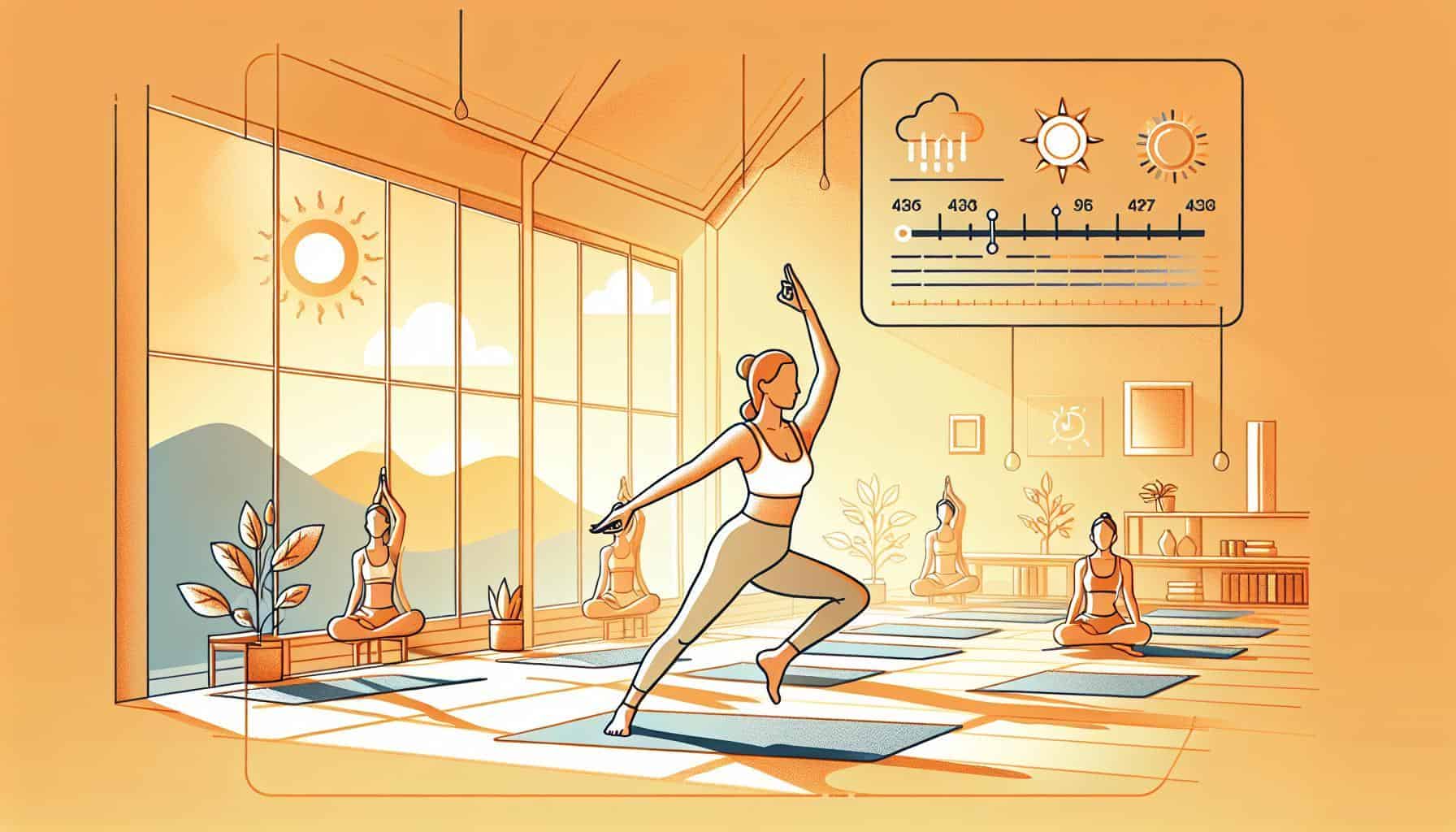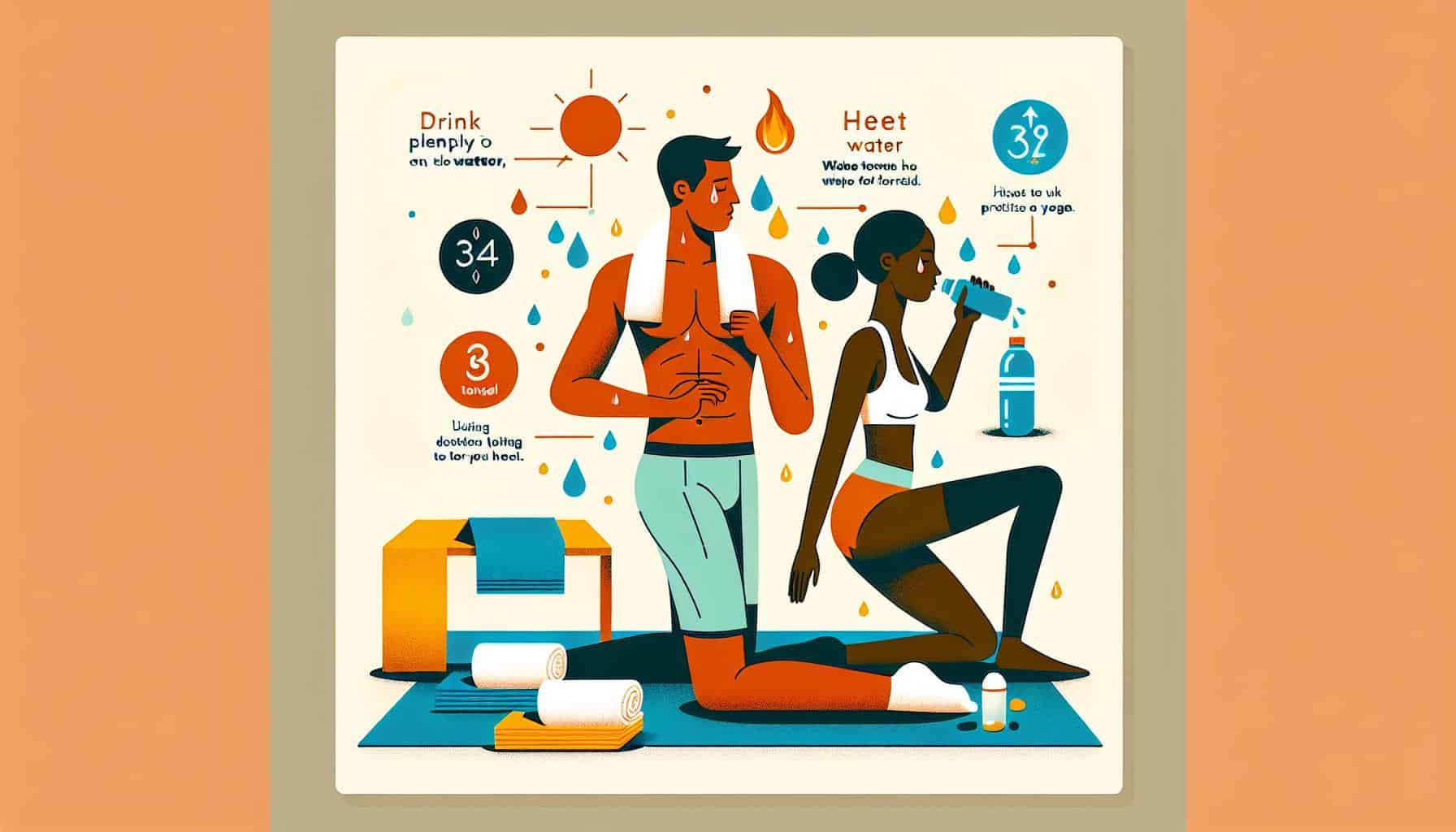Is Hot Yoga Safe In Summer? How To Practice Safely In Summer (2025)
As the mercury rises, so does the debate: Is hot yoga your best summer workout buddy, or a heatstroke hazard in disguise? You’ve embraced the warmth of hot yoga studios during the chillier months, but with summer’s sizzle, you’re wondering if it’s wise to continue.
While stepping outside feels like a dive into a steamy pool, hot yoga can still be on your summer wellness roster. Studies confirm it’s generally safe for most people, but with the added intensity of the season, you’ll need to up your hydration game. Stay tuned as we unfold the precautions that’ll help you strike a balance between your love for hot yoga and the summer heat.
The Debate: Is Hot Yoga Safe in Summer?
You’re aware that hot yoga studios are often heated to around 105°F with substantial humidity to mimic the climate of India. Layer on summer temperatures, and concern around safety increases. The core of the debate lies in how the body copes with elevated temperatures during intense exercise, such as hot yoga.
Safety always comes first. When practicing hot yoga in the summer, dehydration is a significant concern. The intense heat contributes to rapid fluid loss, making it crucial to drink more water. Heat exhaustion is another potential risk, particularly if you’re subjected to high temperatures outside the studio too. This could manifest as dizziness, nausea, or muscle cramps, signs you shouldn’t ignore.
Although you may find reports of hot yoga as a culprit for muscle damage due to overstretching, experts suggest that being mindful of your body’s limits is key. In fact, some studies argue that with proper hydration and caution, hot yoga can be beneficial regardless of the season. It allows for increased flexibility and might even enhance stress relief.
However, acclimatization to the heat plays a significant role. If you’re regularly exposed to hot environments, your body might be better equipped to handle the additional stress of a hot yoga session. Those who haven’t adapted might find it tougher to regulate their core body temperature, which is crucial to prevent overheating.
Before rolling out your mat, evaluate your overall heat exposure. If you’re someone who enjoys summer outdoor activities on top of hot yoga, doubling up might increase your risk for dehydration and heat-related illnesses. Pausing to reflect on how much time you spend in the heat can guide you to a safer practice.
The practice of hot yoga, like any form of physical activity, demands attentiveness to your body’s messages. If you’re feeling off, it’s best to take a step back, cool down, and rehydrate. Listening to your body remains the universal advice for safely navigating the realm of hot yoga during any season.
Embracing Hot Yoga Studios Year-Round
 Hot yoga is a gift that keeps on giving, regardless of the rise and fall of temperatures. Adapting to the environment of a hot yoga studio year-round can have lasting benefits on your physical and mental state. During the summer, when most dread the thought of additional heat, hot yoga might just be the ticket to elevating your wellness game.
Hot yoga is a gift that keeps on giving, regardless of the rise and fall of temperatures. Adapting to the environment of a hot yoga studio year-round can have lasting benefits on your physical and mental state. During the summer, when most dread the thought of additional heat, hot yoga might just be the ticket to elevating your wellness game.
Flexibility improves in the heat, and summer amplifies this effect. As the mercury climbs, your muscles become more pliable. This advantage allows you to explore a greater range of motion and potentially excel in postures that seemed challenging in cooler months. Take these warmer times to focus on Joint Flexibility, Core Strength, and Spinal Mobility. You’ll be amazed at the improvements in your practice.
Stay Hydrated and replenish your electrolytes; this is paramount for any physical activity, especially so during hot yoga in the summer. The practice teaches you to monitor and understand your body’s Hydration Needs, establishing habits that benefit you outside the studio. Furthermore, the summer’s heat might reduce your appetite, enabling a feeling of lightness that can dramatically enrich your Yoga Practice.
Expanding on the practicality of hot yoga, the controlled environment of the studio prepares you for the Outdoor Activities you pursue in the summer. Whether it’s running, biking, or simply enjoying a walk in the park, your body becomes acclimatized to the heat through regular practice. As a result, you’ll likely find an increase in endurance and a better tolerance for heat during your favorite summer sports or activities.
Remember, adapting to hot yoga studios year-round isn’t just about maintaining a fitness routine—it’s about embracing a lifestyle that supports your overall wellbeing, regardless of the season. By engaging in hot yoga during the summer, you’re not just surviving the heat; you’re learning how to thrive in it.
Summer’s Intense Heat: The Challenge for Hot Yoga
When the summer heat peaks, your body’s temperature regulation gets put to the test, especially during high-intensity workouts like hot yoga. These workouts are not just a physical challenge but also a test of your body’s ability to cope with high temperatures and maintain hydration.
With studio temperatures soaring between 90°F and 105°F, and humidity around 40%, hot yoga becomes an ingenious replication of the summer heat, only intensified. This controlled environment can optimize your body’s heat adaptation, but it’s crucial to recognize the body’s signals to prevent heat-related illnesses such as heat stroke or heat exhaustion.
- Stay Hydrated: Your body will sweat profusely, potentially depleting vital minerals and salts. It’s essential to drink plenty of fluids before, during, and after class.
- Electrolyte Replenishment: Electrolytes facilitate muscle function and nerve impulses. Ensure electrolyte levels are sufficient by using supplements or electrolyte-rich drinks.
- Acclimatization: Gradually increasing the duration and intensity of sessions can better prepare your body.
- Balance Rest with Activity: Give your body time to recover between sessions to avoid overexertion.
Understanding Your Body’s Limits
Listening to your body is never more important than during a scorching summer hot yoga class. Symptoms like dizziness, nausea, or extreme fatigue are warning signs that should not be ignored. Tuning in to these warnings ensures that you’re not pushing past your safety threshold.
Monitoring Heart Rate: An elevated heart rate is common in hot yoga due to the stress of heat and exercise. However, it should remain within a safe range relative to your fitness level.
Embracing hot yoga in the summer months offers the opportunity to improve flexibility and build endurance. Nonetheless, it’s paramount to approach your practice with a sense of caution and a deep understanding of personal health and fitness. Remember that modifying poses and taking breaks are not signs of weakness but of smart and informed practice. By respecting your body’s responses to the intense summer heat within the hot yoga studio, you can ensure a beneficial and safe experience throughout the season.
Precautions for Practicing Hot Yoga in the Summer
During the sizzling summer months, hot yoga demands a specific regimen to ensure your safety and enhance the benefits of your practice. Here are some critical precautions to keep in mind when the temperatures soar.
Stay Hydrated
Hydration is paramount. You’re not only facing the external heat but also the challenge of a hot yoga studio, which intensifies the dehydration process. Be proactive and drink plenty of water before, during, and after your class. Opt for beverages that replenish electrolytes, particularly if you plan to spend time outdoors or don’t have access to air conditioning.
Adjust Your Diet
The heat may reduce your appetite, providing an advantage in your yoga practice. With a lighter stomach, you’re likely to experience increased comfort and deeper immersion into the poses. However, ensure your diet still includes nutrient-rich foods to maintain energy levels and facilitate recovery.
Acclimatize Your Body
Gradually acclimate to the warmer temperatures by starting with shorter durations in the hot yoga class and gradually increasing your time as your body adjusts. This can improve your tolerance for heat both in and out of the yoga studio and boost endurance for your favorite summer activities.
Wear Appropriate Attire
Select yoga wear that is breathable and moisture-wicking to support adequate ventilation and comfort during practice. The right clothing can make a significant difference in how you cope with and respond to the heat.
Monitor Your Health
Being in tune with your body is crucial. Recognize and respect your limits to avoid pushing yourself beyond a safe point. While practicing hot yoga, if you experience dizziness, lightheadedness, or nausea, take a break. It’s essential to listen to your body’s signals to prevent heat-related illnesses.
By taking these precautions, you’ll not only improve the safety of your summer hot yoga sessions but also potentially enhance your overall fitness and enjoyment of the season’s athletic pursuits. Remember, the goal is not to challenge your body’s limits but to acknowledge and work within them to foster a sustainable, long-term practice.
Striking a Balance: Love for Hot Yoga vs. Summer Heat
 When tackling the subject of hot yoga during the sweltering summer months, your main concern might be how to maintain your practice without compromising your wellbeing. As outdoor temperatures soar, remember that your body’s ability to cope with excessive heat is variable. You’ll need to harness a balance that recognizes the benefits of hot yoga yet pays heed to the intensity of the summer heat.
When tackling the subject of hot yoga during the sweltering summer months, your main concern might be how to maintain your practice without compromising your wellbeing. As outdoor temperatures soar, remember that your body’s ability to cope with excessive heat is variable. You’ll need to harness a balance that recognizes the benefits of hot yoga yet pays heed to the intensity of the summer heat.
Your love for hot yoga shouldn’t eclipse the importance of listening to your body. Signs of heat exhaustion, including dizziness, headache, and muscle cramps, must never be underestimated. In such cases, limiting the duration of your sessions or opting for yoga at cooler times may be prudent. Alternatively, adjusting the temperature in the studio – if possible – could afford you the best of both worlds; the delightful intensity of hot yoga and a nod to summer’s peak temperatures.
In favor of your fitness regimen, remember that exercising in heated environments increases joint flexibility and promotes deeper postures. Yet, this increased flexibility should be approached with caution to avoid overstretching and potential injuries. Your summer hot yoga sessions can become more about maintaining agility and less about pushing limits. This balance is key to a sustainable and beneficial practice.
Moreover, staying hydrated becomes non-negotiable during these months. Proper hydration and electrolyte balance are crucial as they influence your ability to perform and recover. It’s not just about drinking water; it’s about replenishing what you sweat out. This includes minerals like sodium and potassium, which are essential in preventing hyperthermia and muscle fatigue.
Remember, adapting your yoga practice for the summer doesn’t mean losing its essence. It’s about making thoughtful adjustments that affirm your dedication to health and mindfulness. By acclimating your body gradually and respecting its signals, you can enjoy the physical and mental boosts that hot yoga promises, even in the height of summer.
Conclusion
Hot yoga can be a rewarding yet intense experience during the summer. It’s essential to prioritize your well-being by staying hydrated and dressing appropriately. Remember to listen to your body’s signals and take the necessary steps to avoid heat-related issues. By making smart adjustments, you’ll be able to enjoy the benefits of hot yoga without compromising your health. Keep these tips in mind, and you’re sure to have a safe and invigorating practice even as the temperatures rise.
Frequently Asked Questions
Is hot yoga safe to practice during summer?
Hot yoga can be safe during summer if proper precautions are taken, such as staying hydrated, dressing appropriately, and acclimatizing to the heat. It’s important to listen to your body and watch for signs of heat exhaustion.
What precautions should I take while doing hot yoga in summer?
Ensure you’re well-hydrated, wear breathable clothing, and give your body time to adapt to high temperatures. Also, adjust your diet accordingly, monitor your health closely, and be mindful of not overexerting yourself.
Can hot yoga improve flexibility even in the summer heat?
Yes, hot yoga can improve flexibility as the heat loosens your muscles and joints. However, be cautious of overstretching and potential injuries, especially during the intense summer heat.
What are the benefits of practicing hot yoga in summer?
The benefits of hot yoga in summer include increased flexibility, muscular strength, reduced inflammation, and better mood. It’s essential to take appropriate measures to enjoy these benefits without risking health.
How do I prevent dehydration and electrolyte imbalance in hot yoga during summer?
Drink plenty of water before, during, and after your practice, and consider incorporating electrolyte-replenishing drinks if exercising for prolonged periods or if you sweat profusely.
How can I tell if I’m overdoing hot yoga in the heat?
Watch out for symptoms like excessive fatigue, lightheadedness, confusion, dizziness, nausea, or muscle cramps. If you experience these, it’s essential to cool down, hydrate, and possibly consult a health professional.
Is it possible to acclimate to hot yoga in the summer?
Yes, your body can acclimate to hot yoga in the summer. Start gradually with shorter sessions and lower intensity, allowing time for your body to adapt to the heat and increase the pace as comfortable.
What’s the best attire for hot yoga in the summer?
Choose moisture-wicking, breathable, and light-colored clothing that allows easy movement and helps keep your body cool during the practice.
What are the signs of heat exhaustion during hot yoga?
Signs of heat exhaustion include heavy sweating, weakness, cold, pale and clammy skin, weak pulse, fainting, and vomiting. If you experience these signs, stop exercising immediately, move to a cooler environment, and hydrate.

